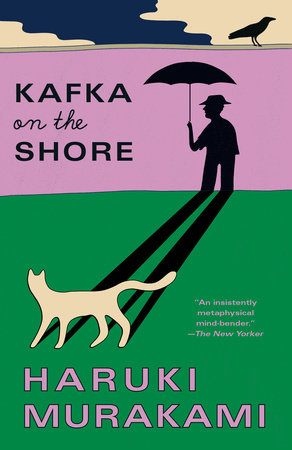Kafka on the Shore Reader’s Guide
By Haruki Murakami


1. The first character to speak in Kafka on the Shore is the “boy named Crow” [p. 3]. Who is he? What part of Kafka Tamura’s psyche does he represent?
2. “Kafka,” we later learn, means “crow” in Czech. What relationship is Murakami trying to suggest between Franz Kafka, Kafka Tamura, the boy named Crow, and actual crows? At what significant moments do crows appear in the novel? What symbolic value do they have?
3. When Kafka meets Sakura on the bus, they agree that “even chance meetings . . . are the results of karma” and that “things in life are fated by our previous lives. That even in the smallest events there’s no such thing as coincidence” [p. 33]. What role does fate, or meaningful coincidence, play in the novel? Is it karma that determines Kafka’s destiny?
4. Much of the novel alternates between Kafka’s story and Nakata’s. What effects does Murakami create by moving the reader back and forth between parallel narratives? What is the relationship between Nakata and Kafka?
5. When Kafka is a young boy, his father tells him: “Someday you will murder your father and be with your mother” [p. 202], the same destiny as Oedipus. Kafka’s father also tells him that he will sleep with his sister and that there is nothing he can do to prevent this prophecy from being fulfilled. How do Kafka’s attempts to escape his fate bring him closer to fulfilling it?
6. The phrase “for the time being” is repeated throughout Kafka on the Shore. Why has Murakami chosen to use this qualifying statement so often? How is the conventional concept of time stretched and challenged by events in the novel? Why does Miss Saeki tell Kafka: “Time’s rules don’t apply here. Time expands, then contracts, all in tune with the stirrings of the heart” [p. 219]?
7. In what ways are the boundaries between past and present, dreaming and waking, fantasy and reality blurred and often erased in Kafka on the Shore?
8. The teacher in charge of the children who lost consciousness in the woods during World War II writes to her professor many years later and tells him: “I find the worldview that runs through all of your publications very convincing—namely that as individuals each of us is extremely isolated, while at the same time we are all linked by a prototypical memory” [p. 96]. How are the main characters of the novel—Kafka, Nakata, Oshima, Miss Saeki—“extremely isolated”? In what ways do they share a “prototypical memory”? What would that memory be?
9. Kafka Tamura seems, in some mysterious way, to be both Miss Saeki’s son and the ghost of her long-dead lover. How does Murakami intend us to understand this shifting and apparently impossible dual identity?
10. What is the relationship between Nakata’s quest for the “entrance stone” and Kafka’s journey into the forest?
11. In what ways can Kafka on the Shore be read as a love story?
12. The supernatural shape-shifter, who takes the form of Colonel Sanders, tells Hoshino that he is neither God nor Buddha but a kind of “overseer, supervising something to make sure it fulfills its original role. Checking the correlation between different worlds, making sure things are in the right order” [p. 284]. What are these different worlds? Is Colonel Sanders talking about parallel universes?
13. Kafka on the Shore is, for the most part, a realistic novel, yet it contains many magical elements—Nakata’s ability to talk with cats and make fish fall from the sky, the shape-shifting Colonel Sanders, the middle-aged Miss Saeki visiting Kafka as her fifteen-year-old self. What is Murakami saying about the nature of reality and our beliefs about it through these seemingly impossible episodes?
14. At the end of the novel, Oshima tells Kafka, “You’ve grown up” [p. 463]. In what ways has Kafka been changed by his experience? What are the most important things he has learned? Why does he feel he has entered “a brand-new world” [p. 467]?
Just for joining you’ll get personalized recommendations on your dashboard daily and features only for members.
Find Out More Join Now Sign In